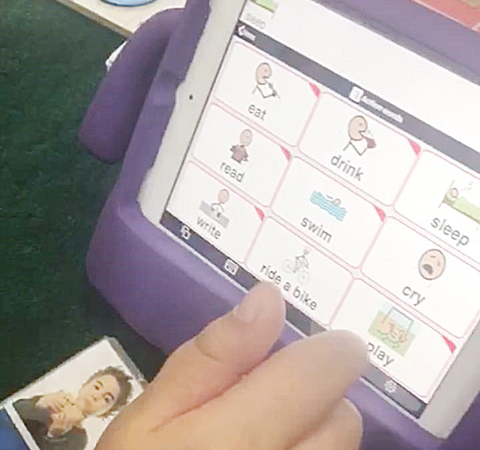 .
.KUWAIT: Smart electronic devices and applications could be a curse for children, but they are a blessing for peers with special needs. Numerous studies have shed lights on the grave impacts of electronic devices, smart phones and tablets, on children's health and behavior, but for children with special needs, they have proved to be instrumental in helping them better communicate and integrate into the society.
When Mohammad Omar, a 10-year-old Kuwaiti boy, was two years and eight months, he was diagnosed with autism spectrum disorder, ASD, which includes a wide range, "a spectrum," of symptoms, skills, and levels of disability such as difficulty communicating and interacting with others; and repetitive behaviors as well as limited interests or activities. Directly after the diagnosis, his family started a long treatment journey at home and abroad.
Firstly, Omar was sent to the United States where he stayed for two years receiving intensified therapy sessions, each takes up to eight hours a day. Then he was transferred to a specialized medical center in the United Arab Emirates to complete treatment. Upon returning home, his family employed to a special doctor to help the child develop required skills for his everyday life.
"Since his conceptions 10 years ago, I have never heard the voice of my son," tearful mother Sara Jarragh said. "To communicate with him, we restored to sign language and then moved to photo cards. But when he was in the United Arab Emirates, one of his doctors advised us to use a smart application to help Omar express himself, his needs and communicate with others."
She pointed out that the application can be downloaded and installed on smart phones and other electronic devices such as tablets. This application includes many sections which cover different aspects of life such as colors, shapes, animals, plants, and people, from which Omar chooses what he wants to build a sentence which the app loudly utters on his behalf. "This app has become the voice of voiceless people," Jarragh said, describing the app as "a major breakthrough."
Jarragh said that she has read about the negative impacts of electronic devices on children, but the use of electronic devices was a blessing for the case of her son. "I would continue using such kind of apps till I hear the voice of my son," she stressed.
Spina Bifida
Ali Al-Hadi has a bit different story from that of Omar. Hadi, two years and a half Kuwaiti boy, was diagnosed with Spina Bifida which is a birth defect where there is incomplete closing of the backbone and membranes around the spinal cord.
His mother, Ghadeer Baqer, uses smart devices applications and social networking sites to spread awareness about Spina Bifida which few people know anything about and offer counseling and help to pregnant mothers whose fetus was diagnosed as having the same illness.
"These applications and sites have also helped me create a community for families with Spina Bifida children to support each other," Baqer said. She has also used the electronic devices to show Al-Hadi video clips of other Spina Bifida peers and how they take their medications and use assistive devices to help them walk and live their daily life.
"I wanted to ease some of his emotional suffering and to show him that he is not the sole child going through this difficult situation," she said. Baqer, however, said that she is not for using electronic devices for playing and entertainment at this age.
"At this age, real-world playing, talking with family members and acquiring cognitive and physical skills are greatly better than being glued in front of screens of electronic devices," she said. "He is fond of cars and knew the Arabic and English names of different vehicles, cars and trucks. He also loves animals and dinosaurs and likes making shapes with clay."
To blame
But Pediatrics and Emergency Consultant Dr Abdullah Shamsah begged to differ. Despite some positive and useful usage of electronic devices, he believes that these devices are to blame for the steadily growth children's learning difficulties, hypertension, speech delay, isolation, obesity, lethargy, nervousness, and a heap of other psychological, physical and behavioral disorders.
"Taking into account the graveness of the problem, I have recently written a post (on social networking sites) about my plan to hold a symposium for parents to raise awareness and warn them about the negative impacts of such devices and how work out solutions and create alternatives," he said.
"The idea was greatly welcomed by a huge number of followers, many of whom expressed willingness to volunteer to help organize this symposium and provide more advices and specialized information about the psychological and social effects of the electronic devices on children."
He went on to say "after my first meeting with volunteers, the idea evolved from a one-time symposium to an integrated campaign, themed device-free time." The campaign attracted a slew of doctors, specialists, technicians and administrators and parents and sets set of goals and executive plans, he said. "These people are eager to work to educate parents, educators and raise children awareness about the dangers and negative impacts of the excessive use of smart devices on both children and their families," he clarified.
He pointed out that the campaigners seek to spread awareness through social networking sites, seminars, workshops, courses as well as visits to schools and civil societies. He noted that the success achieved by the campaign in its first activity last month, which included lectures for a number of specialists and workshops for children to learn how to enjoy their time away from smart devices. - KUNA










